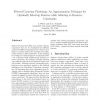466 search results - page 88 / 94 » How to study artificial creativity |
AIR
2006
13 years 8 months ago
2006
Abstract Storing and retrieving time-related information are important, or even critical, tasks on many areas of Computer Science (CS) and in particular for Artificial Intelligence...
KDD
2004
ACM
14 years 8 months ago
2004
ACM
Transformation of both the response variable and the predictors is commonly used in fitting regression models. However, these transformation methods do not always provide the maxi...
ATAL
2008
Springer
13 years 10 months ago
2008
Springer
Effective norms, emerging from sustained individual interactions over time, can complement societal rules and significantly enhance performance of individual agents and agent soci...
ATAL
2008
Springer
13 years 10 months ago
2008
Springer
In repeated games with incomplete information, rational agents must carefully weigh the tradeoffs of advantageously exploiting their information to achieve a short-term gain versu...
SPLC
2008
13 years 9 months ago
2008
Software Product-lines (SPLs) use modular software components that can be reconfigured into different variants for different requirements sets. Feature modeling is a common method...

